Dissipative Output Tracking Control of Linear Systems with Time Delay
Abstract
The problem of dissipative output tracking control of linear systems with time delay is investigated. Firstly, an augmented system is constructed to describe dissipative output tracking control error, and the concept of dissipative output tracking is defined. Based on this, some sufficient conditions are derived in terms of linear matrix inequalities (LMIs) technique, which ensure that the augmented system is dissipative and stable; then design methods of dissipative output tracking state-feedback controller are provided, and the desired controller gain can be expressed through the solutions of LMIs. Finally, a numerical simulation example is given to illustrate the validity of the proposed results.
1. Introduction
Output tracking control is one of the most fundamental and important control problems in control theory and applications. The essence of output tracking control is to enable controlled output to approach reference output as closely as possible. Output tracking control has been applied successfully to many fields, such as aircraft [1], robot [2–4], and biomathematics [5]. Meanwhile, many control methods have been developed in this area to analyze and control systems. The authors in [6] have studied the adaptive asymptotic tracking problems for a class of large-scale systems. Many results on the fuzzy adaptive tracking control problems have been obtained in [7–9]. By using a sliding-mode controller/observer scheme, the authors in [10] have solved robust output tracking problems. In [11], the authors have investigated output tracking problem for uncertain nonlinear systems. Robust output tracking control problem has been discussed for time-delay nonlinear systems by neural network in [12]. H∞ output tracking control has been studied by T-S fuzzy model approach in [13]. [14] has studied H∞ output tracking problems for network-based control systems. The chaotic tracking control has been first investigated for SIR epidemic model in [15]; a tracking control method is given to control chaotic motion in the epidemic model, and the corresponding state feedback controllers are designed such that the density of infected individuals can converge to zero. In [16], the tracking control of chaos is studied for singular biological economy systems; a controller is designed which guarantees that the output of chaos system can track an expected constant value or period orbit. In order to eliminate the chaos or Neimark-Sacker bifurcation of the discrete epidemic model, a tracking controller is designed in [17] such that the disease disappears gradually. Different new results about output tracking control have been obtained in these literatures which provide us significant and useful control approaches.
Notion of dissipativity was introduced by Willems in 1970s [18, 19], which can be regarded as a generalization of H∞ performance as well as positive realness performances and passivity. Essentially, the practical interpretation of dissipativity is that there exists a nonnegative storage function such that energy consumption rate is less than a given energy supply rate. The representative researches of dissipative theory for linear systems can be found in [20–22]. However, to the best of our knowledge, there are no research on output tracking control problems from the perspective of dissipativity. All of these motivate us to achieve the current study.
In this paper, dissipative output tracking control problem is formulated for linear time-delay systems. From the view of dissipativity, the process of output tracking control can be regarded as the process of energy dissipation. Dissipative output tracking control generalizes some previous results about output tracking control, including H∞ output tracking control, whose concept is first presented for linear time-delay systems in this paper. Then, some sufficient conditions are derived such that the considered systems are dissipative and stable by employing LMIs technique. Following these results, dissipative output tracking controllers are designed which also ensure the resultant closed-loop systems to be stable. Compared with some existing results, this paper provides a new way to solve output tracking control problems for linear time-delay systems.
This paper is organized as follows. Dissipative output tracking control problem is formulated in Section 2. By using PI control method, the output tracking control problem of the original system is transformed into the dissipative analysis problem of an augmented system. In Section 3, some sufficient conditions are explored for the augmented system with and without time delay to be dissipative, and then the corresponding dissipative output tracking controllers are designed. In Section 4, we bring a demonstrative example to show the effectiveness of the proposed method. Some conclusions are drawn and some potential research interests are stated in Section 5.
2. Problem Formulation
In order to make the output vector y(t) approaches the reference output vector yref(t) asymptotically, the following concept is introduced for system (5) from the view of dissipativity.
Definition 1. For system (5) with a given supply rate r(yref(t), e(t)), if there exists a nonnegative storage function V(x(t)) with V(0) = 0 such that the following dissipative inequality
We first present the following lemmas which will be used later.
Lemma 2. Assume system that (A, B) is controllable. Then augmented system (AL, BL) is controllable if and only if
Proof. First let . Then
Remark 3. It is noted that Lemma 2 gives a necessary and sufficient condition for the augmented system to be controllable. As we know, if a system is controllable, then the eigenvalues of the system can be assigned arbitrarily, which implies that the system can be stabilized. This lemma explains the relationship that, under appropriate condition, the stabilizability of the original system can ensure the stabilizability of the augmented system, which has a potential application in controller design.
Lemma 4 (Schur complement [23]). For a given symmetric matrix S ∈ ℝn×n, and , where are matrix blocks with appropriate dimensions, the following statements are equivalent:
- (1)
S < 0;
- (2)
S11 < 0, ;
- (3)
S22 < 0, .
3. Main Results
Consider the supply rate (8), then for system (11), we have the following results.
Theorem 5. For the time-delay system (11) and the given supply rate (8), if the following LMIs
Proof. Combine system (11) with the storage function (12), then the time derivative of V(xL(t), t) along the trajectory of system (11) is given as
Associated with the supply rate (8), we have
Therefore, if LMIs (13) have feasible solutions P and V, it is from Definition 1 that linear time-delay system (11) is dissipative.
Next, we show the stability of system (11). To this end, assume that system (11) is strictly dissipative, then we separate J into
Then, we have the following result for system (21).
Theorem 6. For system (21) and the given supply rate (8), if the following LMIs
Proof. For system (21), the time derivative of storage function V(xL(t), t) along the trajectory of system (21) is given as
It is noted that when system (21) is strictly dissipative, we have
For the augmented system (5), we present a controller design method in the following theorem which guarantees that the closed-loop system (29) is both strictly dissipative and stable.
Theorem 7. For the linear time-delay tracking system (29) and the given supply rate (8) with Q < 0, if the following LMIs
Proof. According to Theorem 5, for the given supply rate (8) and the closed-loop system (29), if the following LMIs
Premultiply and postmultiply diag {P−1, I, P−1} to the matrix inequality (33), and assume that X = P−1, W1 = K1X, W2 = K2X, M = XVX, then using Schur complement lemma, the LMI (30), which is equivalent to the matrix inequality (33), can be obtained. Therefore, if the LMI (30) has feasible solutions , , and X*, then is the desired dissipative state-feedback controller. This completes the proof.
Remark 8. It is noted that Theorem 7 provides a controller design method such that the resultant closed-loop system (29) is not only strictly dissipative but also stable, which can be more desirable to be obtained.
Remark 9. It should be pointed out that the designed controller of the form (28) is more general than some existing results. When K2 = 0, the controller (28) reduces to the instant state feedback, while in case of K1 = 0, it is just a retarded state feedback.
Consequently, the following design method can be obtained.
Theorem 10. For system (36) and the given supply rate (8) with Q < 0, if the following LMIs
Proof. According to Theorem 6, for the given supply rate (8) and system (36), if LMIs
Pre-multiply and post-multiply the matrix inequality (39) with diag {P−1, I}, and assume that X = P−1, W = KX. According to Schur complement lemma, LMI (37), which is equivalent to the matrix inequality (39), can be obtained. Therefore, if the LMI (37) has feasible solutions W*, X*, then u(t) = KxL(t) = W*(X*) −1xL(t) is the dissipative state-feedback controller. This completes the proof.
4. Numerical Simulation
- (1)
choose r(t) = 5cos (t), when , xref(0) = 0, output tracking trajectory is shown in Figure 1; when , xref(0) = 1, output tracking trajectory is shown in Figure 2;
- (2)
choose r(t) = 0, when , xref(0) = 0, output tracking trajectory is shown in Figure 3; when , xref(0) = 1, output tracking trajectory is shown in Figure 4;
- (3)
choose r(t) = (sin(t)) 2 + cos (t), when , xref(0) = 0, output tracking trajectory is shown in Figure 5; when , xref(0) = 1, output tracking trajectory is shown in Figure 6.
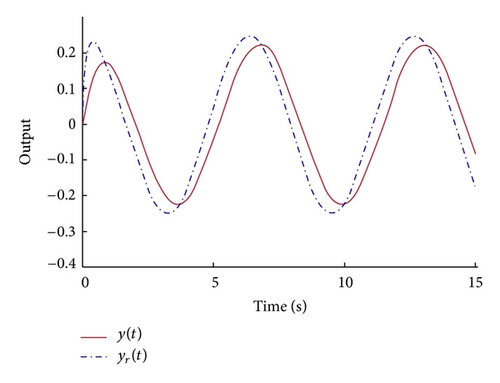

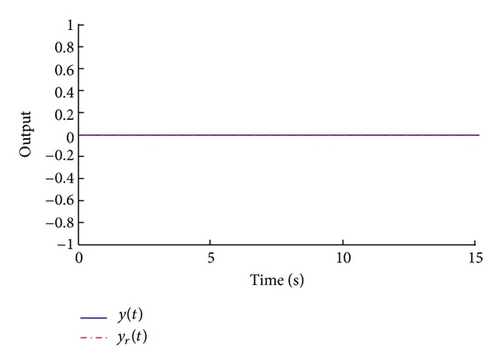
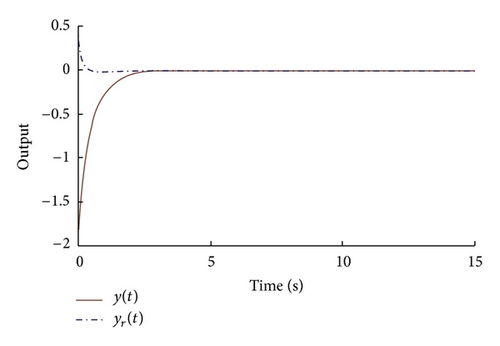
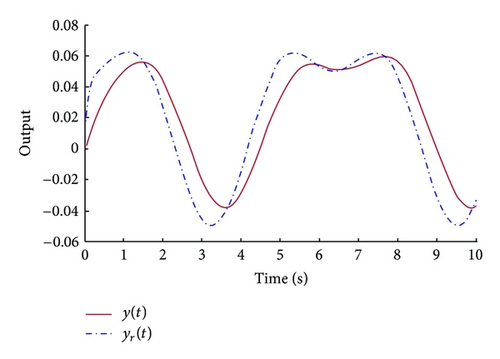
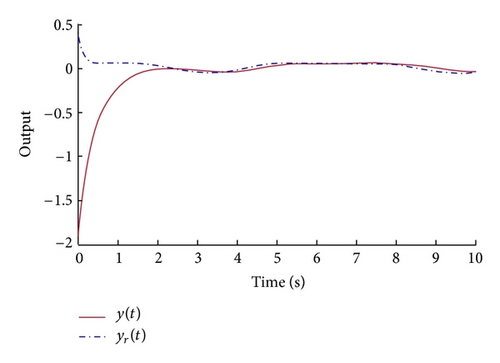
According to Figures 1–6, we find that the output vector can approach the reference output vector as closely as possible; it is obvious that our proposed method is very effective.
5. Conclusion
By the example and the theorems, we can draw the following conclusions. Compared with most output tracking control methods, this paper realizes the output tracking performance by stable and dissipative controllers. The theorems are computationally simple and practically effective. Meanwhile, there still exist many problems that need to be solved. The tracking performance should be further investigated, and in the presence of uncertainties, the robust dissipative control for the systems is also worthy to be studied.
Acknowledgment
This work was partially supported by The Natural Science Foundation of China under Grants nos. 60974004, 61273003, and 61273008, respectively.




